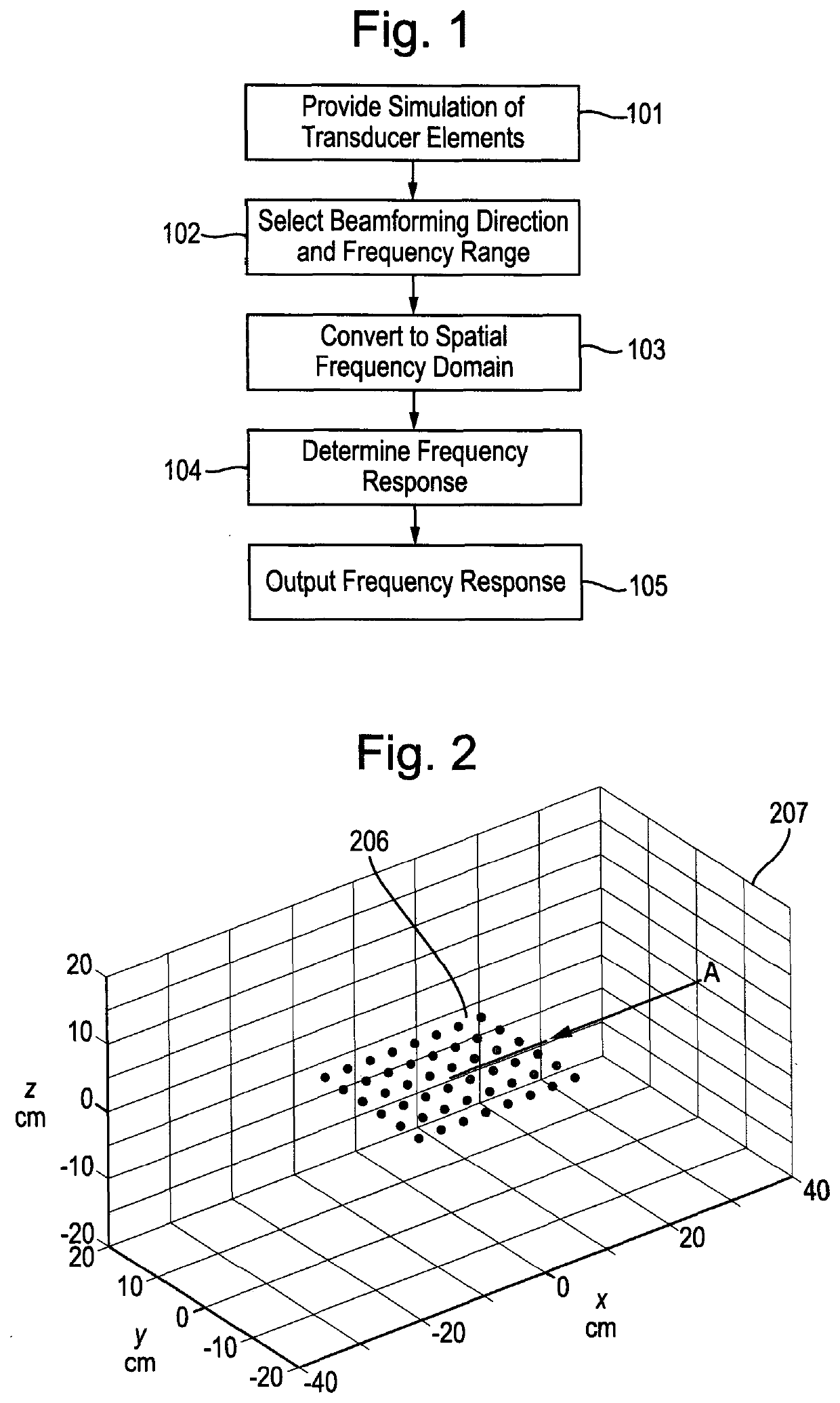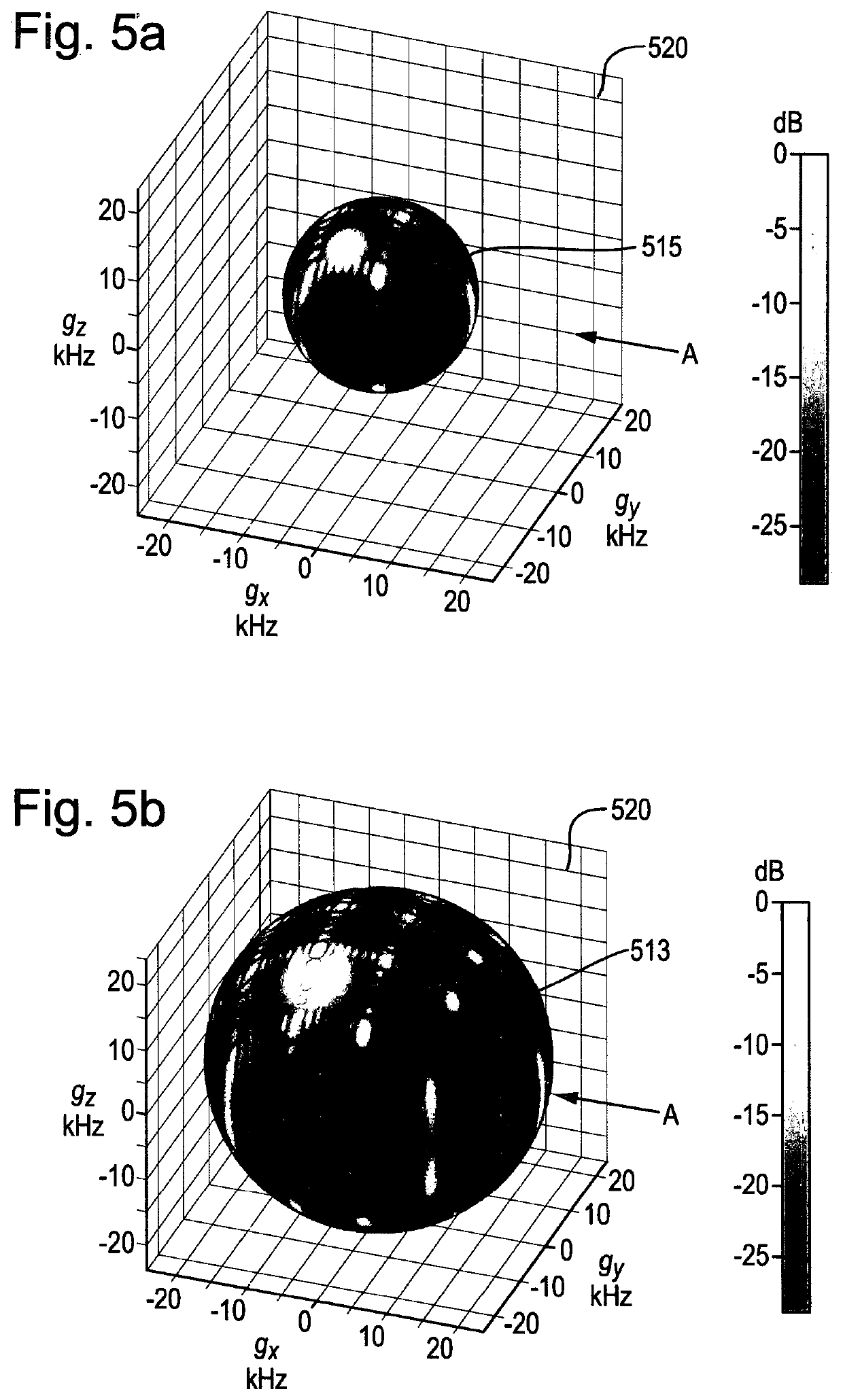Method and apparatus for determining the directional frequency response of an arrangement of transducer elements
- Summary
- Abstract
- Description
- Claims
- Application Information
AI Technical Summary
Benefits of technology
Problems solved by technology
Method used
Image
Examples
first embodiment
[0077]With reference to FIG. 1, in the method of determining the directional frequency response of an arrangement of transducer elements, a simulation of the locations of an arrangement of transducer elements is provided 101 as a periodic spatial function. The transducer elements, having a two-dimensional arrangement, are located in an xy plane of the spatial domain, having spatial coordinates x,y. The transducer elements could equally have a one-dimensional or a three-dimensional arrangement. The periodic spatial function is determined by sampling the sensor space with an infinite grid of lattice points. A sinc filter is used as an anti-aliasing filter to determine appropriate gain values at each of the lattice points due to the proximity, or otherwise, of any transducer elements.
[0078]A beamforming direction and frequency range are provided appropriate to the intended application 102, being to determine the directional frequency response of an arrangement of microphones for detect...
second embodiment
[0085]With reference to FIG. 2, in the method of determining the frequency response of an arrangement of transducer elements, 48 microphone transducer elements 206 are arranged in two dimensions in the xy plane of the spatial domain 207. Each of the 48 microphones is configured to receive sound in the selected frequency range of 0 Hz to 24 kHz. The beamforming direction is specified relative to the arrangement of transducer elements, in the positive x direction, to detect signals travelling in the negative x direction as indicated by arrow A. The frequency range of 0 Hz to 24 kHz is selected. Equally, other beamforming directions and frequency ranges may be selected.
[0086]The 48 microphones are equidistantly spaced at 36 mm in the x direction and 39 mm in they direction, and, for the purposes of determining the simulation of their locations, are defined within a sensor space having dimensions of 3.6 m×3.6 m. The resulting periodic spatial function of the arrangement of 48 microphone...
fourth embodiment
[0097]With reference to FIGS. 7a and 7b, in the method of determining the frequency response of an arrangement of transducer elements, seventeen microphone transducer elements 706 are arranged in two-dimensional concentric rings in the xy plane of the spatial domain 707. Each of the seventeen microphones is configured to receive sound in the selected frequency range of 0 Hz to 12 kHz. The beamforming direction is specified relative to the arrangement of transducer elements 706, in the positive x direction, to detect signals travelling in the negative x direction as indicated by arrow Z. The frequency range of 0 Hz to 12 kHz is selected. Equally, other beamforming directions and frequency ranges may be selected.
[0098]The seventeen microphones 706 are arranged in three concentric rings, and, for the purposes of determining the simulation of their locations, are defined within a sensor space having dimensions of 7.2 m×7.2 m. The resulting periodic spatial function of the arrangement of...
PUM
 Login to View More
Login to View More Abstract
Description
Claims
Application Information
 Login to View More
Login to View More - R&D
- Intellectual Property
- Life Sciences
- Materials
- Tech Scout
- Unparalleled Data Quality
- Higher Quality Content
- 60% Fewer Hallucinations
Browse by: Latest US Patents, China's latest patents, Technical Efficacy Thesaurus, Application Domain, Technology Topic, Popular Technical Reports.
© 2025 PatSnap. All rights reserved.Legal|Privacy policy|Modern Slavery Act Transparency Statement|Sitemap|About US| Contact US: help@patsnap.com



